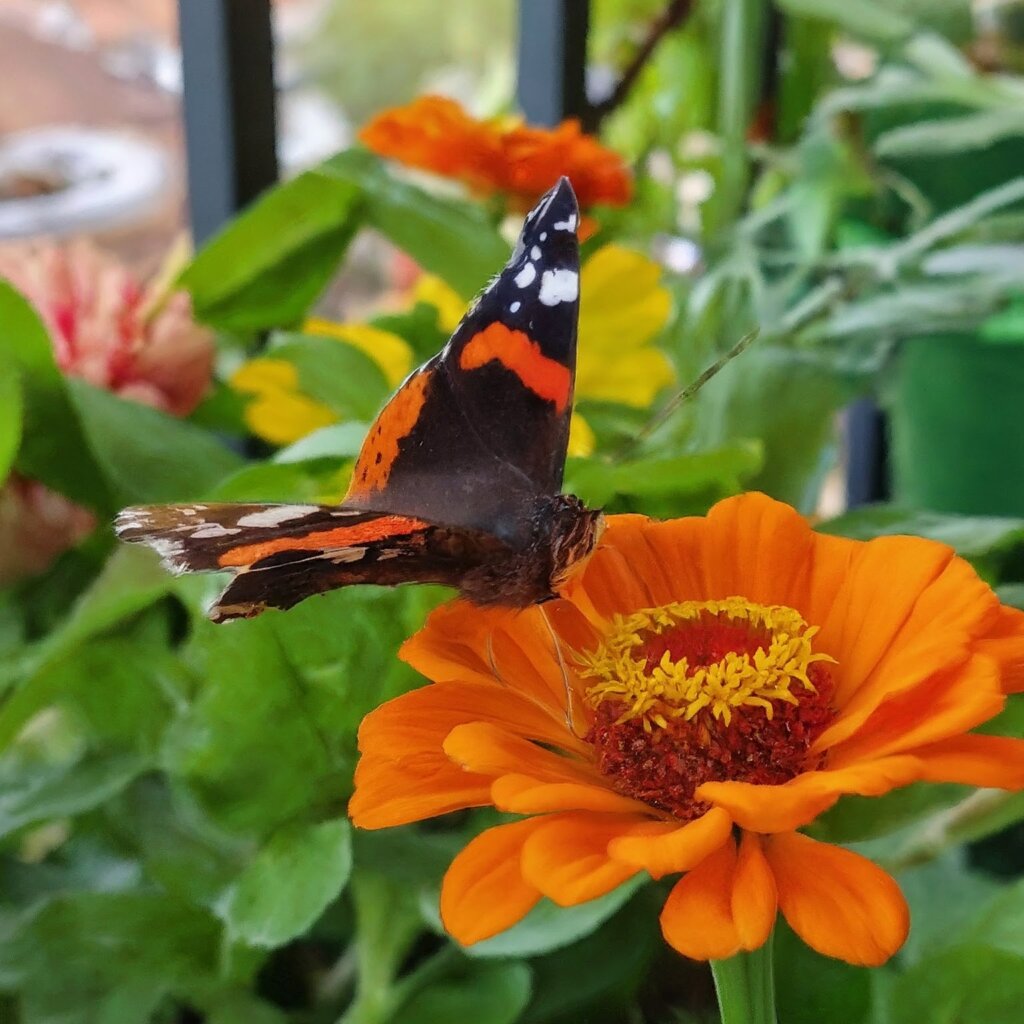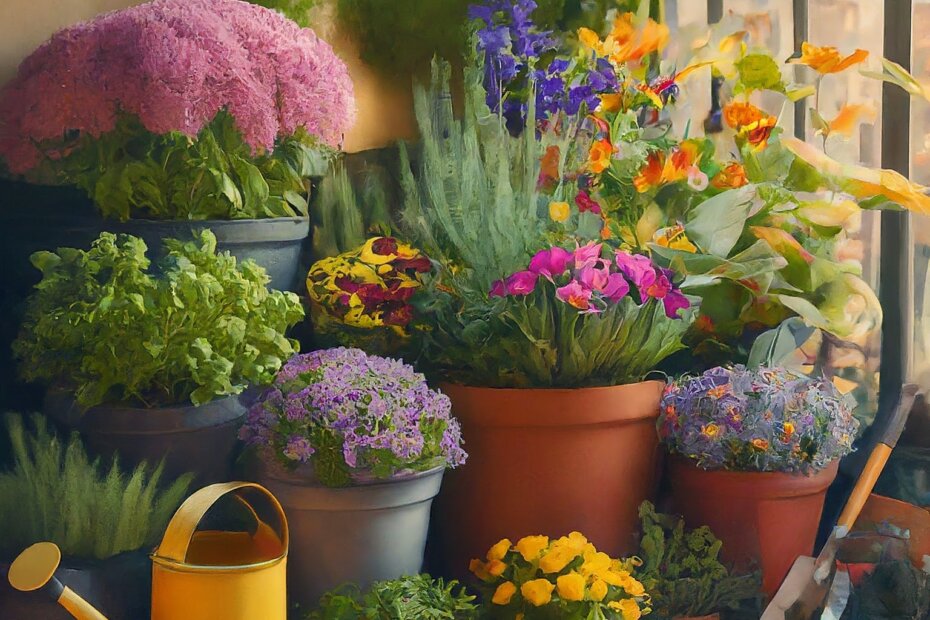Do you dream of having a lush garden but live in an apartment or city home with limited outdoor space? Don’t give up on your green thumb aspirations just yet! Balcony gardening allows you to create a verdant oasis no matter how small your plot is.
By cultivating plants right outside your door, you can reap numerous benefits for the environment, your mental health, and your physical well-being. What was once an underutilized balcony space can transform into a flourishing garden, producing fresh food and adding pops of color to your world.
Balcony gardens are rapidly gaining popularity as urban dwellers seek ways to reconnect with nature and embrace eco-conscious practices. This trend has many positive side effects that we’ll explore in depth. From purifying the air to providing hyper-local food sources, the (benefits of balcony gardening) extend far beyond creating an attractive outdoor nook.
So what are you waiting for? Join the balcony gardening movement and discover how this simple act can have profound impacts on you and your surroundings. Let’s dig into the multitude of rewards that await the urban gardener!
Environmental Benefits of Balcony Gardening

One of the biggest pluses of tending a balcony garden is the positive environmental impact it can have. While a single balcony garden may seem insignificant, the collective effect of many urban gardeners can be powerful for cities.
Air Purification

Plants are nature’s air filters, absorbing carbon dioxide and releasing oxygen through photosynthesis. Having planters of vegetation can help purify the air immediately around your home, essentially creating your oxygen supply. Some plants like snake plants and English ivy are particularly effective at cleansing indoor air of pollutants.
Reduced Carbon Footprint

Growing your food, even on a small scale, reduces emissions from transporting grocery store produce. According to studies, the average family can lower their carbon footprint by 25% by growing just $700 worth of vegetables annually. Balcony gardening is a hyper-local solution for urban areas.
Increased Biodiversity

Urban environments tend to have lower biodiversity compared to rural areas. By introducing flowering plants and crops, balcony gardens can attract bees, butterflies, and other pollinators vital to ecosystems. This creates pockets of biodiversity that can help reverse habit loss.
Fighting Urban Heat Islands

Clustered cities tend to experience “heat island” effects due to the prevalence of heat-absorbing concrete and lack of vegetation. Expanding green spaces, even small ones like balcony gardens can help minimize surfaces that trap hot air and cool the surrounding areas through moisture evaporation from plants.
With strategic plant selection and a commitment to green practices, balcony gardeners are micro-influencing their immediate environments for the better. Even the smallest of gardens can contribute to cleaner air, lower emissions, biodiversity support, and cooler cities.
Cultivate Your Mind: Mental Health Benefits of Balcony Gardening

When it comes to gardening, the benefits extend far beyond the physical. Tending to plants can provide immense boosts to mental well-being. Balcony gardening, despite its small scale, offers a peaceful escape and therapeutic outlet right at home.
Stress Relief and Relaxation
Gardening allows you to step away from stressors and engage in a calming, mindful activity. According to a study in the Netherlands, two groups were instructed to complete a stressful task. The group that gardened for 30 minutes after had significantly lower cortisol (the stress hormone) levels compared to those who read a book. The act of getting your hands in the soil and focusing on tending plants can provide a healthy stress-relieving break.
Improved Mood and Sense of Purpose
Nurturing plant life can give a sense of purpose and accomplishment as you watch them sprout, blossom, and bear fruits or veggies. This feeling of achievement boosts self-esteem and releases “happy hormones” like dopamine for an improved mood. Gardeners benefit from a therapeutic routine.
Reconnecting with Nature Urban living can often feel disconnected from the natural world. But balcony gardening serves as a gateway to nature connection and its associated mental health perks. Numerous studies link time spent in nature with reduced anxiety, depression, and negative emotions while increasing life satisfaction.
Building Community Whether swapping seeds, sharing tips, or showing off prized crops, balcony gardeners find common ground. This gardening camaraderie reduces loneliness and creates a supportive community for those with a shared passion for plants.
From lowering stress levels to instilling purpose and nature appreciation, the mental health effects of balcony gardening are wide-ranging. Consider it an easy, hyper-local tool for self-care and well-being in any living space.
Harvest Physical Wellness: Benefits of Balcony Gardening

While balcony gardens may be petite, they can yield huge rewards for your physical health. From providing nutrition to offering low-impact exercise, cultivating this green space pays dividends for your body.
Access to Fresh, Nutrient-Dense Produce With a balcony garden, you have ultra-fresh food right at your fingertips. Fruits and veggies start losing nutrients quickly after being picked, but balcony crops are the absolute freshest you can get. You also control how your produce is grown, allowing you to choose organic, pesticide-free methods. This ensures you get maximum nutritional value.
Outdoor Exercise and Mobility Gardening is not an intense workout but does promote movement, flexibility, and light exercise – major benefits for an aging population. Planting, weeding, watering, and maintaining garden beds keeps you bending, lifting, and moving outdoors. These gentle activities can improve strength, dexterity, and mobility while getting your daily dose of mood-boosting vitamin D from sunshine.
Stress-Reducing Physical Activity The physical movements of gardening provides an outlet for stress release. Digging, pruning, raking and other repetitive tasks can induce a meditative, tranquil state. These purposeful motions are calming while getting you outside breaks inertia from sedentary indoor routines.
Home-Grown Food Motivation Many find it easier to stick to healthy eating habits when their efforts yield edible rewards. Growing your fruits, veggies, herbs, and greens provides healthy “grow food, not junk food” motivation. The produce tastes better, and you’re more likely to make it a regular part of your diet.
Whether nurturing nutritious eats or getting moving outdoors, balcony gardening is an easy physical health solution right outside your doorstep. Just some basic plant care can lead to a healthier lifestyle.
Growing a Balcony Garden: Planting Your Urban Oasis

Ready to start reaping the incredible benefits of balcony gardening for yourself? Follow these beginner tips to cultivate your slice of nature right outside your door.
Assess Your Space The first step is evaluating your balcony environment. Determine how much space you have available and the amount of direct sunlight that hits different areas throughout the day. This will guide what types of plants will thrive.
Container Gardens Are Key
Since you lack open ground, containers and pots are essential for balcony gardening. Look for sizeable planters with drainage holes that can accommodate your desired plants’ root systems. Windowboxes, hanging baskets, and vertical gardening setups can maximize limited space.
Plant Selection
Match plants to your balcony’s conditions, choosing varieties suitable for the amount of sunlight and container depth. Generally, leafy greens, herbs, cherry tomatoes, and compact flowers fare well. Don’t be afraid to get creative with unique edible landscapes!
Small Space Solutions Limited square footage requires smart strategies. Use trellises for vining crops like cucumbers. Go vertical by mounting wall planters. Place taller plants in the back and shorter varieties up front. Get creative to maximize every nook and cranny!
With a bit of planning and the right plant picks, you can transform even the tiniest balcony into a lush, productive oasis. Contained gardens are the key to this compact form of gardening bliss.
Nurturing Your Balcony Bounty: Care and Maintenance

Once your urban garden takes root, keeping plants happy and thriving requires some routine care and maintenance. Staying on top of these key elements will ensure a bountiful balcony oasis all season long.
Watering Wisely Properly hydrating plants is essential, as balcony containers dry out faster than in-ground gardens. Check soil moisture frequently and water thoroughly when the top inch is dry. Self-watering pots and drip irrigation can make this chore easier.
Fertilizing for Maximum Growth Since plants are contained, they’ll eventually deplete nutrients in the potting soil. Feed every few weeks during the growing season with a balanced liquid fertilizer or add slow-release pellets to give them an extra boost.
Controlling Pests Naturally
Small container gardens can attract insects and other uninvited guests. Practice sustainable pest management like introducing predators (ladybugs eat aphids!), hand-picking bugs, or using neem oil or insecticidal soap sprays.
Dealing with Weather Extremes While balconies provide some shelter, plants are still exposed to elements like driving rain, winds, and heat waves. Move containers to shady spots as needed and invest in frost clothes for surprise late/early frosts.
With a few simple but consistent routines, you can keep your balcony garden thriving and reaping the rewards of ultra-fresh food and beautiful blooms! Staying attentive to water, nutrients, pests, and environmental conditions promotes plant resilience.
Think Outside the Planter Box: Creative Balcony Gardening Ideas

Don’t just settle for a basic row of pots – get innovative and design a truly unique balcony garden! With a bit of creativity and some unconventional planters, you can craft an urban oasis overflowing with personality.
Window Boxes and Hanging Baskets Make use of vertical space by adding window boxes to rails or ledges. These long planters are perfect for trailing vines, cascading flowers, and compact edibles like strawberries or greens. Complement them with hanging baskets brimming with vibrant blooms.
Vertical Gardens Why restrict your garden to the floor? Mount planters or install a vertical garden system on balcony walls or railings. Living walls covered in edible greens or succulents create an incredibly fresh, modern aesthetic.
Herb Gardens Containing your favorite culinary herbs is a no-brainer for balcony gardening. Plant multiple varieties in windowboxes right outside the kitchen for ultra-fresh seasonings within arm’s reach. Or create an aromatic garden of themed herb combinations.
Flower Gardens For a burst of color and a cheerful atmosphere, opt for flower gardens on your balcony. Choose compact bloomers like petunias, zinnias, or marigolds for brilliant pops. You can even mix in flowering edibles like nasturtiums.
Edible Landscapes Rather than separating by plant type, blend edibles and ornamentals into an “edible landscape.” Let vining cherry tomatoes trail from a basket over a carpet of violas, or mix feathery dill with bright calibrachoa blooms.
With an eye for design, your potted plants can become creative masterpieces! Don’t be afraid to step outside the box and blend colors, textures, and edible elements into your customized oasis.
Don’t Let Obstacles Keep You From Balcony Gardening Bliss

While incredibly rewarding, balcony gardening does come with its fair share of challenges, especially in an urban environment. But with some proactive planning and strategic problem-solving, you can overcome these potential roadblocks.
Limited Space One of the biggest hurdles is the spatial constraints of most balconies. Maximize every inch by:
- Using vertical solutions like trellises, hanging baskets, wall planters
- Choosing compact, bush varieties over sprawling vine crops
- Looking for nesting/stacking pots to conserve floor space
Weather Extremes Balcony gardens are exposed to elements like scorching sun, driving rains, and whipping winds – all of which can damage or stress plants. Mitigate with:
- Shelters, shade cloths, windscreens to create microclimates
- Moving potted plants to covered areas during storms
- Selecting climate-appropriate, hardy cultivars
Pests and Critters Urban gardens seem to attract their fair share of uninvited guests like aphids, squirrels, and even rats. Deploy smart pest management by:
- Using row covers and barriers to block access
- Sprinkling diatomaceous earth as a sharp deterrent
- Introducing beneficial predators (ladybugs, lacewings, etc.)
- Properly cleaning up fallen produce
With thoughtful planning and a few strategic solutions, you can clear the common hurdles of balcony gardening. Don’t get discouraged – a little creativity and persistence is key to success!
Here is a draft for the Conclusion section:
Embrace Balcony Gardening For a Healthier, Happier Life
As we’ve explored, the benefits of balcony gardening extend far beyond simply decorating your outdoor space with potted plants. By cultivating this micro urban oasis, you can truly enrich your life and surrounding environment in profound ways.
From purifying the air and increasing biodiversity to providing a steady supply of ultra-fresh, nutritious produce, the environmental impacts make balcony gardening an eco-conscious choice. On a personal level, getting your hands dirty offers a therapeutic reset, reducing stress while reconnecting you to nature’s calming presence.
Engaging in this gentle, rewarding hobby keeps you active, promotes mobility, and motivates healthy eating habits as you quite literally enjoy the fruits (and veggies!) of your labors. Creating your own compact garden is an accessible form of self-care that pays dividends for mental and physical well-being.
While every balcony garden will encounter unique spatial constraints and environmental challenges, don’t let potential obstacles deter you. With creative solutions and dedication, you can transform even the smallest spaces into a lush, bountiful oasis that enriches your world.
So stake your claim to an uplifting new hobby and embrace balcony gardening! Reap the incredible benefits while adding vibrant life to your doorstep. An urban gardening oasis awaits – all you need to do is start sowing the seeds.
FAQs on Balcony Gardening for Beginners
Starting a balcony garden can seem daunting with limited space and experience. Here are some answers to frequently asked questions that new urban gardeners often have:
Q: What plants grow best on balconies? A: The ideal balcony plants depend on your space and sunlight, but many edibles and ornamentals thrive in containers. Top choices include tomatoes, peppers, greens, herbs, strawberries, flowers like petunias or marigolds, and compact varieties of larger vegetables like carrots or beans.
Q: How much sunlight do balcony gardens need? A: Most plants require at least 6 hours of direct sunlight per day, though leafy greens and root crops can manage slightly less. Observe the sun patterns on your balcony and choose crops accordingly or supplement with grow lights.
Q: How do I provide proper drainage? A: Adequate drainage is crucial to prevent soggy soil and root rot. Use containers with drainage holes and a tray underneath to catch excess water. Or, drill additional holes if pots don’t have enough openings.
Q: How often should I water my plants? A: Check soil moisture frequently, as balcony gardens dry out quicker. A general rule is to water thoroughly whenever the top inch of soil is dry. Self-watering pots can reduce maintenance.
Q: How big do containers need to be? A: Container size depends on what you’re growing. For example, tomatoes need at least a 5-gallon pot, while herbs can thrive in 6-8-inch pots. Larger is better to allow adequate root growth.
Q: Should I buy seeds or starter plants? A: Seeds are more cost-effective but require planning and care. Starter plants give you an easier head start, but cost more upfront and limit variety. Try a mix for beginners.
Q: How can I deter common pests? A: Use row covers, and barriers like diatomaceous earth, and introduce beneficial predators like ladybugs. Also, clean up debris and overripe produce promptly.
